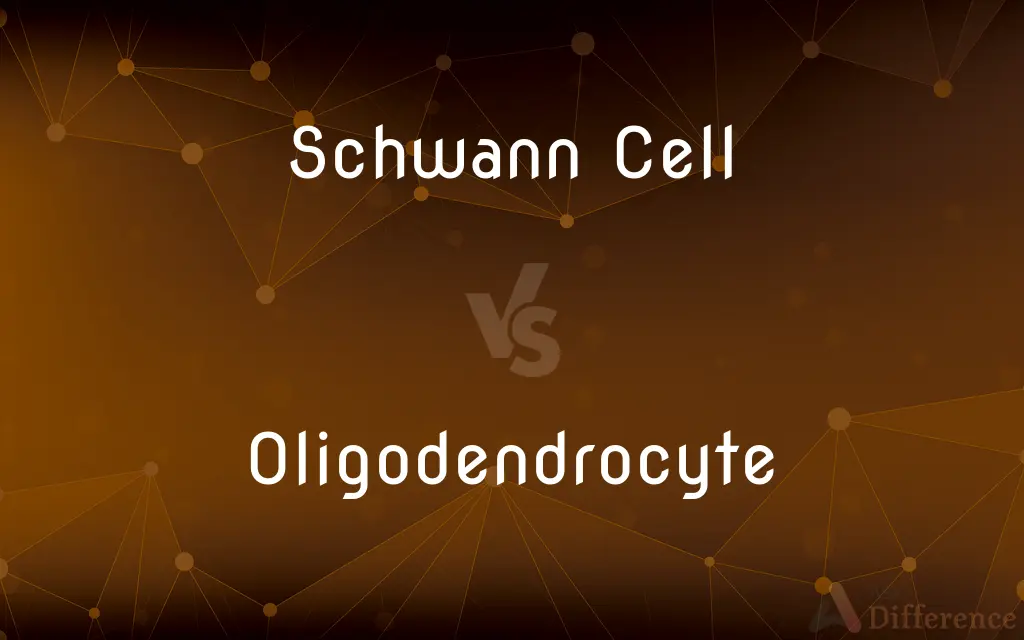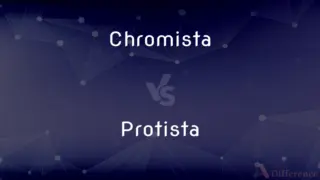Schwann Cell vs. Oligodendrocyte — What's the Difference?
By Tayyaba Rehman — Published on December 19, 2023
Schwann cells myelinate peripheral nerve fibers, while oligodendrocytes myelinate central nervous system fibers.

Difference Between Schwann Cell and Oligodendrocyte
Table of Contents
ADVERTISEMENT
Key Differences
Schwann cells and oligodendrocytes are glial cells found in the nervous system. While Schwann cells are present in the peripheral nervous system (PNS), oligodendrocytes are exclusive to the central nervous system (CNS).
Both Schwann cells and oligodendrocytes play a vital role in insulating nerve fibers. However, Schwann cells wrap around a single axon to form myelin sheaths in the PNS, while an oligodendrocyte can myelinate multiple axons in the CNS.
Schwann cells aid in nerve regeneration when injury occurs in the PNS. In contrast, oligodendrocytes, being in the CNS, do not offer the same regenerative capabilities due to the CNS's limited repair mechanisms.
Schwann cells have a cylindrical shape and surround axons. Oligodendrocytes, on the other hand, have multiple extensions that reach out to multiple axons, providing insulation.
One notable distinction between Schwann cells and oligodendrocytes is in their development. Schwann cells develop from neural crest cells, while oligodendrocytes originate from neural stem cells in the CNS.
ADVERTISEMENT
Comparison Chart
Location
Peripheral Nervous System (PNS)
Central Nervous System (CNS)
Myelination
Myelinates a single axon
Can myelinate multiple axons
Regeneration Ability
Aids in nerve regeneration in PNS
Limited regenerative capability in CNS
Origin
Develops from neural crest cells
Originates from neural stem cells in the CNS
Shape and Extensions
Cylindrical and surrounds axons
Multiple extensions that reach multiple axons
Compare with Definitions
Schwann Cell
Schwann cells derive from the neural crest during embryonic development.
Schwann cells, originating from the neural crest, play a pivotal role in the peripheral nervous system's health.
Oligodendrocyte
Oligodendrocytes are glial cells present exclusively in the central nervous system.
Oligodendrocytes in the brain ensure that neurons transmit signals efficiently.
Schwann Cell
Schwann cells wrap around axons to form myelin sheaths in the PNS.
Myelination by Schwann cells allows for faster signal transmission along the nerve fibers.
Oligodendrocyte
Oligodendrocytes have multiple branching extensions.
The many extensions of an oligodendrocyte allow it to reach and myelinate several axons simultaneously.
Schwann Cell
Schwann cells play a crucial role in nerve repair post-injury.
After nerve damage, Schwann cells proliferate and assist in re-myelination.
Oligodendrocyte
Oligodendrocytes provide insulation to multiple axons by forming myelin sheaths.
Unlike Schwann cells, a single oligodendrocyte can myelinate several axons.
Schwann Cell
Schwann cells are cylindrical in shape and serve as insulating agents for neurons.
The cylindrical shape of Schwann cells allows them to tightly wrap around axons.
Oligodendrocyte
Oligodendrocytes originate from neural stem cells in the CNS.
During CNS development, oligodendrocytes differentiate from neural stem cells to assist in axon myelination.
Schwann Cell
Schwann cells are glial cells located in the peripheral nervous system.
Injuries to the peripheral nerves often involve the regeneration aided by Schwann cells.
Oligodendrocyte
Oligodendrocytes lack the regenerative capabilities seen in Schwann cells.
Injuries to the CNS are challenging to repair due to the limited regeneration ability of oligodendrocytes.
Oligodendrocyte
Any of the neuroglial cells of the central nervous system that are responsible for the formation of myelin sheaths in the white matter and that, in the gray matter, are detectable using myelin staining techniques and may provide support for adjacent neurons.
Oligodendrocyte
(biology) Any of the cells of the oligodendroglia in the nervous system
Oligodendrocyte
A cell of the oligodendroglia
Common Curiosities
What are Schwann cells and oligodendrocytes?
Schwann cells are glial cells in the PNS, while oligodendrocytes are glial cells in the CNS.
Do both Schwann cells and oligodendrocytes form myelin sheaths?
Yes, Schwann cells form myelin in the PNS, and oligodendrocytes form it in the CNS.
Which cells aid in nerve regeneration?
Schwann cells aid in nerve regeneration in the PNS, while oligodendrocytes have limited regenerative capability in the CNS.
What is the origin of Schwann cells and oligodendrocytes?
Schwann cells develop from neural crest cells, and oligodendrocytes from neural stem cells in the CNS.
Where are Schwann cells and oligodendrocytes located?
Schwann cells are in the PNS, while oligodendrocytes are in the CNS.
Why are oligodendrocytes unable to aid in nerve regeneration like Schwann cells?
Oligodendrocytes are in the CNS, which has limited repair mechanisms compared to the PNS where Schwann cells reside.
Do any diseases target Schwann cells or oligodendrocytes?
Yes, diseases like Multiple Sclerosis target oligodendrocytes, and certain peripheral neuropathies affect Schwann cells.
Can one oligodendrocyte myelinate multiple axons?
Yes, one oligodendrocyte can myelinate several axons, unlike Schwann cells which typically myelinate one axon.
Are Schwann cells and oligodendrocytes neurons?
No, both are glial cells, which are distinct from neurons.
Why is myelination important?
Myelination by Schwann cells and oligodendrocytes speeds up signal transmission in neurons.
Are Schwann cells and oligodendrocytes similar in shape?
No, Schwann cells are cylindrical, and oligodendrocytes have multiple extensions.
How do Schwann cells respond to nerve injury?
Schwann cells proliferate and assist in re-myelination and nerve repair.
Share Your Discovery

Previous Comparison
Chromista vs. Protista
Next Comparison
Specific Gravity vs. Specific WeightAuthor Spotlight
Written by
Tayyaba RehmanTayyaba Rehman is a distinguished writer, currently serving as a primary contributor to askdifference.com. As a researcher in semantics and etymology, Tayyaba's passion for the complexity of languages and their distinctions has found a perfect home on the platform. Tayyaba delves into the intricacies of language, distinguishing between commonly confused words and phrases, thereby providing clarity for readers worldwide.













































